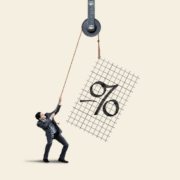Fractional Reserve Is Not the Problem
In the United States, there are once again TV commercials advertising Adjustable Rate Mortgages (ARMs) for residential real estate. Today, I saw one from Quicken Loans promoted with the tagline “why pay more in interest charges now just to know what rate you will have in 2018?” (they are offering a 7-year “teaser” rate and then the loan adjusts after that.
Why indeed?
This sort of promotion should have made people nervous even before the residential real estate bust in the US in 2006.
What has this got to do with Fractional Reserve Banking (FRB)? Banks often commit the same kind of sin. Read on.
There is a common misconception that via FRB, banks lend out more money than they have. But the very definition of fractional reserve banking is that the banks lend out less than their deposits, though they keep less than 100% of their deposits on “reserve”. This misconception comes from the failure to distinguish between money and credit. This is particularly easy to do today because our perverse fiat system has banished money altogether. Gold and silver have no official role. Everything that remains is credit.
A “dollar bill”, aka Federal Reserve Note is the liability of the Federal Reserve. The Federal Reserve has “assets” to back these dollars, namely Treasury bonds (and mortgage back securities, and the Red Roof Inn, and shares of GM, such is the new post-2008 reality). If you have a dollar bill, you have a credit obligation of the Federal Reserve. If you use it to pay a debt you owe to someone, then you transfer the debt from yourself to the Fed. If the recipient deposits the dollar “in” the bank, he is lending it to the bank, and now the bank has a liability to him.
The banking system can create credit. When the bank receives a dollar of deposit, it will often lend $0.90. It still owes the dollar to the depositor. It keeps $0.10 as its asset, and it lends the $0.90 to a borrower. This loan is also the bank’s asset. The borrower, of course, can pay someone and that recipient can deposit the money in the same or another bank. The process can be repeated, and assuming 10% reserves, the total credit in the system can be expanded to a maximum of 10 times the original deposit (the sum of the series 1 + .9 + .81 + .729 …)
The difference between a gold coin in your hand, vs. a piece of paper from a bank promising to pay is made obvious if the bank ever becomes insolvent. The piece of paper is then realized to be a credit instrument in default.
There is a more subtle distinction that few today, even in the Austrian School, make. The difference between: (1) a bank takes a 1-year CD on deposit and lends to a real estate buyer for 30 years; and (2) a bank takes in a 1-year CD and lends to a manufacturer to finance receivables for one month.
The difference is that in one case, the bank’s liability is due before its asset matures. This is similar to what the homebuyer does with the ARM. He may or may not be ready (or able!) to sell the home in less than 7 years. But the loan could be repriced such that it is not economical to hold. At least with residential real estate loans in the US, the loan cannot be called before the final maturity.
The bank that “borrows short to lend long” has no such protection. And in fact this is one of the principal risks that such a bank faces. The depositors can demand their money when their CDs mature (or for demand deposits, they can demand their money at any time). But the bank has issued a loan that it cannot call.
The bank can try to sell it, if there is a bid in the loan market at that moment. If the run on the bank is large, and if the same thing is happening to other banks, the banking system could in its entirety be forced into bankruptcy, with immeasurable damage to depositors. One kind of depositor is the corporate payroll account…
Borrowing short to lend long, also known as “rolling” one’s liabilities, is fraud. No legitimate bank would engage in this activity in a free market (as opposed to our centrally planned central bank based system with bailouts and other forms of “moral hazard”).
The temptation is great, because the rate on short-term borrowing is much lower than the rate on longer-term lending. This is the same temptation faced by the home buyer comparing an ARM to a fixed-rate mortgage.
But just as with stealing, this temptation must be resisted if one is to stay out of trouble, or in this case bankruptcy. For a bank engaged in this practice, collapse is inevitable. It is only a matter of time.
This, not Fractional Reserves per se, is the real problem and the real risk.





